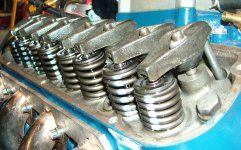dpheyes
Well-known member
I've reached the end of my rope and am looking for any ideas to help get my engine started. Here's the situation:
New/rebuilt 302/347 stroker
Fresh rebuilt Autolite 4300 4V carb
New modern style PMGR starter
New battery
New cables, plugs, wires, distributor, Pertronix, coil, etc.
I've had it nearly started several times, but have "killed" two batteries doing it. It is extremely hard to crank. If I take the plugs out it turns over pretty easily. When I put the plugs back in, it will barely turn over.
I've double-checked:
Transmission is in neutral. Hard to crank even with the clutch disengaged.
Rotation is correct.
Timing is set to approximately 6 BTDC.
Firing order is correct.
Negative battery cable is firmly grounded to bare metal on block.
Engine/firewall ground is firmly grounded to bare metal on block & firewall.
Any ideas greatly appreciated. It's been four long years restoring this and I neeeeeeeed to hear it running!
Doug
New/rebuilt 302/347 stroker
Fresh rebuilt Autolite 4300 4V carb
New modern style PMGR starter
New battery
New cables, plugs, wires, distributor, Pertronix, coil, etc.
I've had it nearly started several times, but have "killed" two batteries doing it. It is extremely hard to crank. If I take the plugs out it turns over pretty easily. When I put the plugs back in, it will barely turn over.
I've double-checked:
Transmission is in neutral. Hard to crank even with the clutch disengaged.
Rotation is correct.
Timing is set to approximately 6 BTDC.
Firing order is correct.
Negative battery cable is firmly grounded to bare metal on block.
Engine/firewall ground is firmly grounded to bare metal on block & firewall.
Any ideas greatly appreciated. It's been four long years restoring this and I neeeeeeeed to hear it running!
Doug




